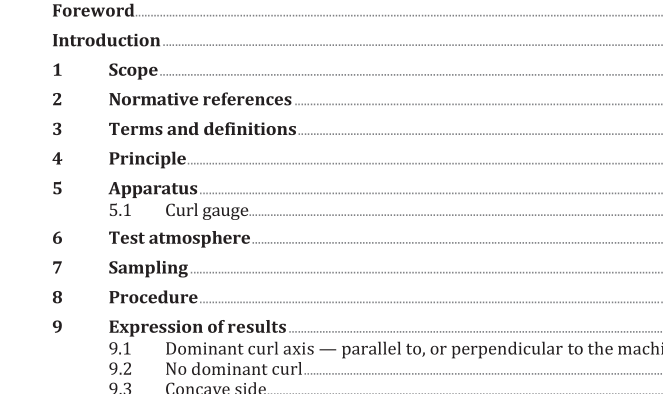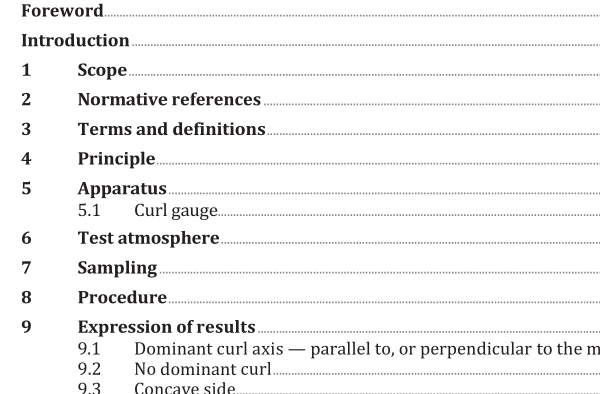ISO 14968:2022 pdf download – Paper and board — Cut-size office paper — Measurement of curl in a pack of sheets.
1 Scope This document specifies a method for the measurement of curl in cut-size office papers. The test method is typically used in evaluating papers of the type described in ISO 216. This method is limited to papers with a maximum dimension of 300 mm in both directions. The measurement can be made on papers as received, after conditioning, or after processing in a copier or printing device. 2 Normative references The following documents are referred to in the text in such a way that some or all of their content constitutes requirements of this document. For dated references, only the edition cited applies. For undated references, the latest edition of the referenced document (including any amendments) applies. ISO 186:2002, Paper and board — Sampling to determine average quality 3 Terms and definitions For the purposes of this document, the following terms and definitions apply. ISO and IEC maintain terminology databases for use in standardization at the following addresses: — ISO Online browsing platform: available at https://www.iso .org/obp — IEC Electropedia: available at https://www.electropedia .org/ 3.1 curl deviation from a flat surface which has three major components: magnitude, direction of curl axis and the side towards which the paper curls 3.1.1 curl magnitude quantitative measure of the deviation of a paper test piece from a flat surface Note 1 to entry: It is expressed as the reciprocal of the radius of curvature, R , of the curled test piece with units of reciprocal metres (m ). Note 2 to entry: The radius of curvature for the curled test piece is the distance from the arc to the centre of a circle, of which the arc forms a part. The reciprocal radius (R ) has a value of zero for a flat sheet. Note 3 to entry: Curl characteristics of paper and board are time-dependent and the magnitude of any curl may be transient. 3.1.2 curl axis direction direction of the curl axis of paper and board, characterized as follows: — curl axis which is perpendicular to the paper ’s machine direction; — curl axis which is parallel to the paper ’s machine direction;
3.1.3 concave side side towards which the paper or board curls Note 1 to entry: See also Annex A . 3.2 double curl form of curl which tends to alternate between the two sides, when the sheet is manipulated lightly Note 1 to entry: This tendency is a phenomenon which may be described as two curl patterns that are finely balanced within the same sheet of paper. 3.3 cut-size office papers papers in the range 60 g/m to 150 g/m which are used for writing and/or in various printing and copying devices 3.4 reference side for a non-imaged paper that side indicated by arrows on the end labels of a sealed ream, that side facing the top of a box of unwrapped sheets or, if arrows, or other instructions, are not present, that side facing the wrapper seam 4 Principle A pack of approximately 10 to 15 sheets is taken from the sample to be tested and the magnitude of the curl is measured, noting the curl axis direction and the side towards which the paper curls. 5 Apparatus 5.1 Curl gauge Consisting of a straight line 210 mm long and companion arcs at least 210 mm long of radii such that their curl magnitude varies between 1,00 m and 10,00 m . The construction of such a gauge is shown in Annex B . Copies of the curl gauge made on a toner-imaging device should not be used because such a device frequently has a built-in enlargement which would change the dimensions of the arcs. It can be convenient to use a set of templates with their edges corresponding to the curl of magnitudes given in Annex B . Each template should be labelled with its curl magnitude.
ISO 14968:2022 pdf download – Paper and board — Cut-size office paper — Measurement of curl in a pack of sheets






